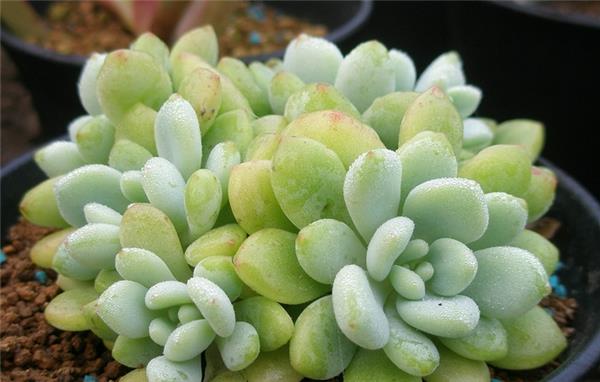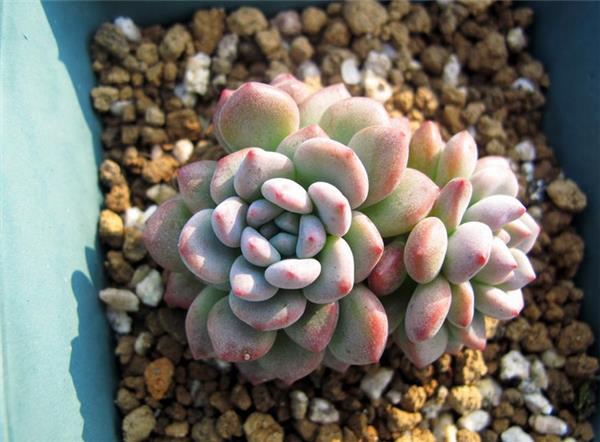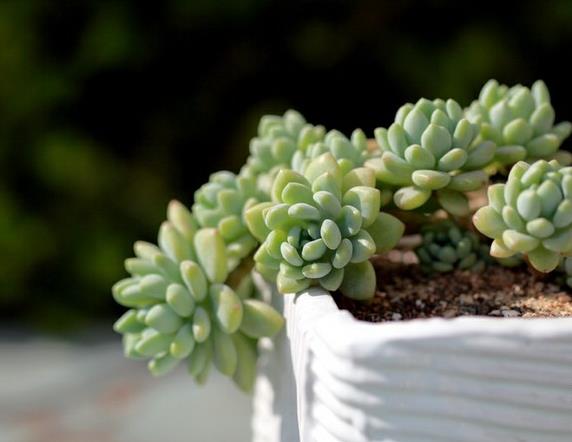How to create a beautiful lotus
Clotting lotus is a succulent plant of Sedum family and Sedum. In Japan, it is called "B Nu Peony" or "Yiji Peony"; "Raul" is the Korean translation of this variety, so let's take a look at the planting method of clotting lotus.

First, the morphological characteristics of clotting lotus.
Nelumbo nucifera is a perennial semi-shrub with many branches. Nelumbo nucifera often produces new buds from the lower part of the stem, forming groups. The leaves are spatulate, alternate, arranged in the shape of a rosette; the surface is smooth, the front is flat, the back is slightly raised, and the flesh is thick, emerald or light green, covered with white powder and densely covered with very fine white particles. In the environment of sufficient light and large temperature difference, the leaf tip will appear beautiful and lovely little red dots, and the leaf color will become jelly-like light green or yellowish green, just like jade fat that is frozen and blown through. There are two different forms of clotting lotus. One has longer and narrower leaves and less frost powder; the other has wider leaves and more frost powder (sometimes called "Raul"); but both forms belong to clotting lotus.

Second, the cultivation techniques of clotting lotus.
Nelumbo nucifera prefers cool, dry and sunny environments and sandy soil with good drainage.
1. Light
The more sufficient the light is, the greater the temperature difference between day and night is, the brighter the leaf color is. When the temperature permits, it is best to put it outside for maintenance to ensure sufficient light. When the light is insufficient or the soil moisture is too much, the whole plant is light green or dark green, and the leaf sparse spacing elongates, which accelerates the upward growth, which seriously affects the ornamental property, and may even die because of the obstruction of plant photosynthesis.
two。 Moisture content
Because of the high water content in the plant, the purple pearl is easy to rot in the excessive humid environment. Don't water too much.
In order to avoid water deposition in the root, it is best to choose a basin with a drainage hole at the bottom, and a red pottery basin with good air permeability can be used for beginners; glass containers are endothermic and have poor air permeability, so they should be used with caution. Reference water quantity: once every 10 days or so, watering thoroughly each time. The watering frequency can be increased or decreased according to the climate differences of different regions and seasons.

3. Soil
It is suitable to be cultivated in sandy soil with good drainage and permeability for the removal of excess water and the growth of plant roots, and can be prepared with rotten leaf soil, sandy soil and garden soil. Changing the basin every 1-2 years in the spring can cut off the necrotic old roots.
4. Temperature
Stop growing or mild frostbite when below 5 degrees Celsius, and water frozen cells in leaves below 0 degrees Celsius are necrotic. When the temperature is too high (more than 35 degrees Celsius) or too low (less than five degrees Celsius) in winter and summer, the plant growth should be temporarily reduced or stopped, and the watering frequency should be restored when the temperature is suitable. Pay attention to ventilation during high temperatures in summer to prevent prolonged exposure to the sun to avoid sunburn.
6. Pruning
Usually need to remove the dry old leaves in time, so as not to accumulate and lead to the growth of bacteria. When the plant grows excessively or grows too high, it can be molded by pruning the top branches and leaves and controlling the plant height to maintain the beauty of the plant type. The top part of the cut can be inserted into the sandy soil after drying the wound to take root and become a new plant. The stems and leaves at the bottom can sprout more lateral buds.

7. Fertilizer
Fertilization should not be too much, especially nitrogen fertilizer, otherwise the plant will grow too long and the leaves will not be red. Apply thin fertilizer dominated by phosphorus and potassium once a month. Maintain in a ventilated environment, otherwise it is easy to get sick. The suitable temperature for its growth is 15-25 degrees, and not less than 5 degrees in winter; during the growing period, watering is dry and thoroughly, and water can be sprinkled around the plant when the air is dry, but the leaf surface, especially the center of the leaf clump, should not accumulate water, otherwise it will cause rotten heart; fertilization is generally applied every 20 days or so. The growing season is that the basin soil is completely dry and then watered in spring and autumn, and shade is needed in summer to reduce watering.
The above are the breeding skills of clotting lotus. I hope I can help you.
- Prev

Introduction and breeding skills of Huan Jian laughing all over Sichuan in Autumn
Introduction and breeding skills of Huan Jian laughing all over Sichuan in Autumn
- Next

The planting skills of orchids introduce how to cultivate beautiful orchids
The planting skills of orchids introduce how to cultivate beautiful orchids
Related
- Wuhan Hospital Iron Tree Blooming Result Was Instantly Frightened by the Gardener Master
- Which variety of camellia is the most fragrant and best? Which one do you like best?
- What is the small blue coat, the breeding methods and matters needing attention of the succulent plant
- Dormancy time and maintenance management of succulent plants during dormancy
- Minas succulent how to raise, Minas succulent plant pictures
- What are the varieties of winter succulent plants
- How to raise succulent plants in twelve rolls? let's take a look at some experience of breeding twelve rolls.
- Attention should be paid to water control for succulent plants during dormant period (winter and summer)
- Watering experience of twelve rolls of succulent plants
- Techniques for fertilizing succulent plants. An article will let you know how to fertilize succulent plants.

